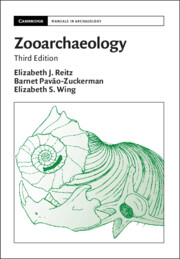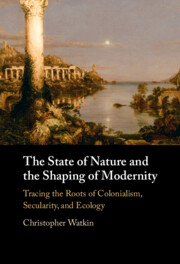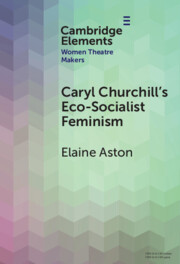Refine search
Actions for selected content:
565 results
2 - Homo the Hunter
-
-
- Book:
- Traces of the Distant Human Past
- Published online:
- 13 December 2025
- Print publication:
- 22 January 2026, pp 104-154
-
- Chapter
- Export citation
Introduction
-
- Book:
- Five Economies of World Literature
- Published online:
- 09 December 2025
- Print publication:
- 31 December 2025, pp 1-15
-
- Chapter
- Export citation
6 - Ecological Imaginaries of the State of Nature
- from Part II - Making Sense through the State of Nature
-
- Book:
- The State of Nature and the Shaping of Modernity
- Published online:
- 19 November 2025
- Print publication:
- 18 December 2025, pp 264-307
-
- Chapter
- Export citation
2 - The Emergence of Creoles and Pidgins
-
-
- Book:
- Uniformitarianism in Language Speciation
- Published online:
- 10 December 2025
- Print publication:
- 18 December 2025, pp 42-103
-
- Chapter
- Export citation
1 - Uniformitarianism in Language Speciation
-
-
- Book:
- Uniformitarianism in Language Speciation
- Published online:
- 10 December 2025
- Print publication:
- 18 December 2025, pp 1-41
-
- Chapter
- Export citation
Conclusion
-
- Book:
- The State of Nature and the Shaping of Modernity
- Published online:
- 19 November 2025
- Print publication:
- 18 December 2025, pp 308-318
-
- Chapter
- Export citation

Zooarchaeology
- Coming soon
-
- Expected online publication date:
- December 2025
- Print publication:
- 18 December 2025
-
- Textbook
- Export citation
Epilogue
-
- Book:
- Making Medical Progress
- Published online:
- 12 December 2025
- Print publication:
- 20 November 2025, pp 171-187
-
- Chapter
-
- You have access
- Open access
- HTML
- Export citation

The State of Nature and the Shaping of Modernity
- Tracing the Roots of Colonialism, Secularity, and Ecology
-
- Published online:
- 19 November 2025
- Print publication:
- 18 December 2025
Phlebotomine sand fly distribution, abundance and pathogen associations in Thailand: a scoping review
-
- Journal:
- Parasitology , First View
- Published online by Cambridge University Press:
- 03 November 2025, pp. 1-16
-
- Article
-
- You have access
- Open access
- HTML
- Export citation
Arcuatula senhousia in the UK: evidence to inform current status and future invasive potential
-
- Journal:
- Journal of the Marine Biological Association of the United Kingdom / Volume 105 / 2025
- Published online by Cambridge University Press:
- 20 October 2025, e118
-
- Article
- Export citation

Caryl Churchill's Eco-Socialist Feminism
-
- Published online:
- 07 October 2025
- Print publication:
- 06 November 2025
-
- Element
- Export citation
New record of Sabellaria miryaensis Parab & Gaikwad, 1990 (Annelida: Sabellariidae) with notes on its associated fauna from the Bay of Bengal, Northern Indian Ocean
-
- Journal:
- Journal of the Marine Biological Association of the United Kingdom / Volume 105 / 2025
- Published online by Cambridge University Press:
- 06 October 2025, e114
-
- Article
- Export citation
Infestation of humans and non-human primates with Cordylobia rodhaini (Diptera: Calliphoridae) in a ‘hotspot’ of furuncular myiasis
-
- Journal:
- Parasitology , First View
- Published online by Cambridge University Press:
- 29 September 2025, pp. 1-7
-
- Article
-
- You have access
- Open access
- HTML
- Export citation
Chapter 30 - Ecology
- from Part V - Afterlives and Future Fields
-
-
- Book:
- Michael Field in Context
- Published online:
- 03 October 2025
- Print publication:
- 25 September 2025, pp 288-296
-
- Chapter
- Export citation
First occurrence of the genus Pandeopsis (Hydrozoa: Anthoathecata) in the South Atlantic Ocean
-
- Journal:
- Journal of the Marine Biological Association of the United Kingdom / Volume 105 / 2025
- Published online by Cambridge University Press:
- 16 September 2025, e103
-
- Article
- Export citation
3 - Making Tarai the Granary of the Province
-
- Book:
- A History of India's Green Revolution
- Published online:
- 07 August 2025
- Print publication:
- 21 August 2025, pp 95-127
-
- Chapter
- Export citation
Chapter 1 - An Introduction Is Like a Book
-
- Book:
- How the World Became a Book in Shakespeare's England
- Published online:
- 09 August 2025
- Print publication:
- 14 August 2025, pp 1-31
-
- Chapter
-
- You have access
- HTML
- Export citation
15 - Warfare in early modern Africa, c. 1450–c. 1850
-
-
- Book:
- The Cambridge History of War
- Published online:
- 18 July 2025
- Print publication:
- 14 August 2025, pp 387-408
-
- Chapter
- Export citation
Chapter 20 - Environmentalist
- from Part III - Culture, Society, and Politics
-
-
- Book:
- María Irene Fornés In Context
- Published online:
- 27 August 2025
- Print publication:
- 07 August 2025, pp 216-226
-
- Chapter
- Export citation
